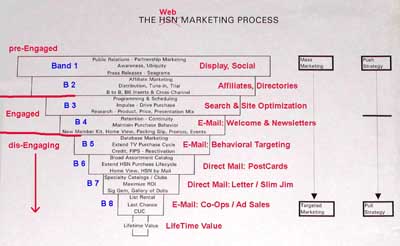After the lessons we learned in the Band 1 and 2 Optimizations (see Band diagram) for HSN, we were able to reallocate that budget to invest in Band 3 – Optimizing the Interface. We realized during the previous Optimizations we were already getting a tremendous amount of traffic through channel surfer / clickers, but this traffic was not “converting”. In other words, we really needed to Optimize the “Landing Page” for this existing audience – the TV show itself.
Don’t suppose the above scenario sounds at all familiar to the web analytics folks out there – you know, “more traffic, any traffic” is the answer? Oops, maybe not, what about higher conversion?
I won’t bother providing the Band 3 example for the web; you all know what Optimizing Landing pages / web sites is about, or can certainly find that info elsewhere. However, you might find the Optimization of a TV shopping channel interesting…
Continue reading Optimizing the Interface (Band 3)